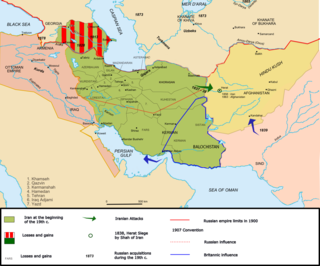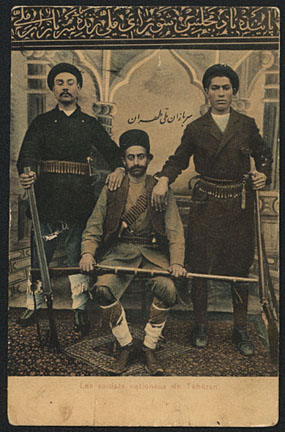Related Research Articles

The Great Game was a rivalry between the 19th-century British and Russian empires over influence in Central Asia, primarily in Afghanistan, Persia, and Tibet. The two colonial empires used military interventions and diplomatic negotiations to acquire and redefine territories in Central and South Asia. Russia conquered Turkestan, and Britain expanded and set the borders of British colonial India. By the early 20th century, a line of independent states, tribes, and monarchies from the shore of the Caspian Sea to the Eastern Himalayas were made into protectorates and territories of the two empires.
Wilhelm Wassmuss was a German diplomat and spy and part of Niedermayer–Hentig Expedition, known as "Wassmuss of Persia". According to British versions of history, he "attempted to foment trouble for the British" in the Persian Gulf in the First World War.

The Anglo-Russian Convention of 1907, or Convention between the United Kingdom and Russia relating to Persia, Afghanistan, and Tibet, was signed on August 31, 1907, in Saint Petersburg. It ended the two powers' longstanding rivalry in Central Asia and enabled them to outflank the Germans, who were threatening to connect Berlin to Baghdad with a new railroad that could potentially align the Ottoman Empire with Imperial Germany.
This article focuses on the status of ethnic minorities in contemporary Iran.

Arthur Chester Millspaugh, PhD, (1883–1955) was a former adviser at the U.S. State Department’s Office of the Foreign Trade, who was hired to re-organize the Finance Ministry of Iran from 1922–1927 and 1942-1945.

William Morgan Shuster, was an American lawyer, civil servant, and publisher, who is best known as the treasurer-general of Persia by appointment of the Iranian parliament, or Majles, from May to December 1911.

Sergei Dmitryevich Sazonov GCB was a Russian statesman and diplomat who served as Foreign Minister from November 1910 to July 1916. The degree of his involvement in the events leading up to the outbreak of World War I is a matter of keen debate, with some historians putting the blame for an early and provocative mobilization squarely on Sazonov's shoulders, and others maintaining that his chief preoccupation was "to reduce the temperature of international relations, especially in the Balkans".

Relations between the Grand Duchy of Moscow and the Persian Empire (Iran) officially commenced in 1521, with the Safavids in power. Past and present contact between Russia and Iran have long been complicatedly multi-faceted; often wavering between collaboration and rivalry. The two nations have a long history of geographic, economic, and socio-political interaction. Mutual relations have often been turbulent, and dormant at other times.

Iran–United Kingdom relations are the bilateral relations between the United Kingdom and Iran. Iran, which was called Persia by the West before 1935, has had political relations with England since the late Ilkhanate period when King Edward I of England sent Geoffrey of Langley to the Ilkhanid court to seek an alliance.

Yeprem Khan, born Yeprem Davidyan, was an Iranian-Armenian member of the Armenian Revolutionary Federation (ARF), revolutionary leader and a leading figure in the Constitutional Revolution of Iran.

The Persian Constitution of 1906, was the first constitution of the Sublime State of Persia, resulting from the Persian Constitutional Revolution and it was written by Hassan Pirnia, Hossein Pirnia, and Esmail Momtaz, among others. The Constitution was also in effect during Pahlavi Iran. It divides into five chapters with many articles that developed over several years. The Quran was the foundation of this constitution while the Belgian constitution served as a partial model for the document, which guaranteed each citizen equality before the law, and a safeguarding of personal honour, property and speech.

The Iranian Gendarmerie, also called the Government Gendarmerie, was the first rural police force, and subsequent modern highway patrol, in Iran. A paramilitary force, it also played a significant part in politics from its establishment in 1910 during the Qajar era until the advent of the Pahlavi era in 1925. It continued to serve until the end of the Pahlavi era and was modernized into the Imperial Iranian Gendarmerie. Originally established as a constitutional army, the force employed Swedish officers in command of Iranian personnel to perform both traditional police duties and conduct military campaigns against tribal forces. In 1991 the Iranian Gendarmerie was merged with other police forces to form the Law Enforcement Command of the Islamic Republic of Iran.

Mohammad-Vali Khan, Khalatbari Tonekāboni ; 1846 – 18 September 1926), known as Sepahdar A'zam, was the leader of the constitutionalist revolutionary forces from Iran's northern provinces of Gilan and Mazandaran and known as one of the greatest statesmen and military commanders of Iranian history as well as its wealthiest nobleman.

The Persian Constitutional Revolution, also known as the Constitutional Revolution of Iran, took place between 1905 and 1911 during the Qajar dynasty. The revolution led to the establishment of a parliament in Persia (Iran), and has been called an "epoch-making episode in the modern history of Persia".

Morteza Gholi Khan was a leader of the Persian Constitutional Revolution and the first Chairman of the first Majlis. A member of the Hedayat family, he served as the Minister of Finance of Iran for seven months.

Esmail Momtaz od-Dowleh was a notable Iranian statesman of the early twentieth century. Born in tehran in 1880, he was one of the original Parliamentarians of the First Majles in 1906. He was also its fourth Speaker.

The Sublime State of Iran, also referred to as Qajar Iran, Qajar Persia, the Qajar Empire, the Sublime State of Persia, or the Guarded Domains of Iran, was the Iranian state under the rule of the Qajar dynasty, which was of Turkic origin, specifically from the Qajar tribe, from 1789 to 1925. The Qajar family took full control of Iran in 1794, deposing Lotf 'Ali Khan, the last Shah of the Zand dynasty, and re-asserted Iranian sovereignty over large parts of the Caucasus. In 1796, Agha Mohammad Khan Qajar seized Mashhad with ease, putting an end to the Afsharid dynasty. He was formally crowned as Shah after his punitive campaign against Iran's Georgian subjects.

The Russian occupation of Tabriz lasted from 30 April 1909 until 28 February 1918, with a brief interruption during 6–31 January 1915. The city of Tabriz was the second city of Qajar Persia at the time, the capital of the region of Azerbaijan, and the traditional residence of the Qajar Crown Prince.

Abu’l-Qāsem Khān Qarāgozlu, known by the title Nāṣer-al-molk, was an Iranian politician who served as Regent, Prime and Finance Minister of Iran during the Qajar dynasty.

The Imperial Russian involvement in the Persian Constitutional Revolution was to support the authoritarian faction led by Mohammad Ali Shah to defeat the constitutionalists. Until 20 April 1909, when the Russian army under Major General I. Snarsky occupied Tabriz to protect the Russian consuls, the Russian Empire indirectly supported Ali Shah and the authoritarian faction. Support from the Russian Empire included sending weapons, lending money to Colonel Vladimir Liakhov, the commander of the Persian Cossack Brigade, and a large-scale propaganda machine against the constitutionalist leaders.
References
- ↑ Foundation, Encyclopaedia Iranica. "Welcome to Encyclopaedia Iranica". iranicaonline.org. Retrieved 2024-07-14.
- ↑ Abrahamian, Ervand (2008). A History of Modern Iran. Cambridge, UK: Cambridge University Press. pp. 55-58.
- ↑ "The Strangling Of Persia by W Morgan Shuster" (PDF).
- ↑ "The Strangling of Persia: A Story of European Diplomacy and Oriental Intrigue". Mage Publishers. Retrieved 2024-07-14.
- ↑ Shuster, William Morgan (1912). The strangling of Persia; a record of European diplomacy and oriental intrigue. Robarts - University of Toronto. London, T.F. Unwin.
- ↑ Shuster, William Morgan (2006). The Strangling of Persia: Story of the European Diplomacy and Oriental Intrigue that Resulted in the Denationalization of Twelve Million Mohammedans, a Personal Narrative.
- ↑ "The strangling of Persia; a story of the European diplomacy and oriental intrigue that resulted in the denationalization of twelve million Mohammedans, a personal narrative,". Library of Congress, Washington, D.C. 20540 USA. Retrieved 2024-07-14.
- ↑ Shuster, William Morgan (2006). The Strangling of Persia: Story of the European Diplomacy and Oriental Intrigue that Resulted in the Denationalization of Twelve Million Mohammedans, a Personal Narrative. pp. 209–220.
- ↑ 1401.شوستر، مورگان. اختناق ایران. مترجم حسن افشار، تهران، نشر ماهی،.